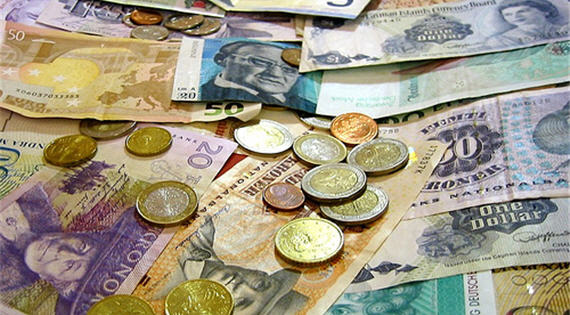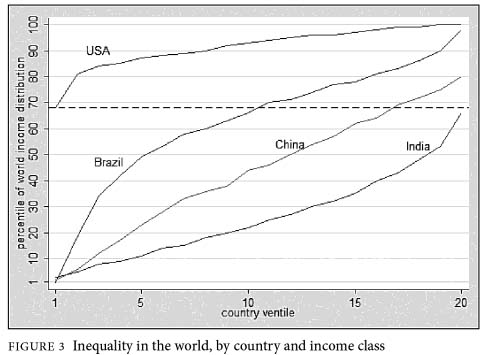Americans Wealthier Than You Think
How rich is the United States? Our poor are richer than the richest in India.
Earlier today, Matt Yglesias passed along his colleague Pat Garofalo‘s post noting that the USA has more income equality than Egypt. My instant response was: Also, radically more poverty.
Independently Laura McKenna added, “How rich is the United States? Our poor are richer than the richest in India.” She pointed to NYT economics editor Catherine Rampell‘s review of Branko Milanovic’s The Haves and the Have-Nots and, in particular, this graphic:
She interprets:
Brazil’s bottom ventile — that is, the poorest 5 percent of the Brazilian population, shown as the left-most point on the line — is about as poor as anyone in the entire world, registering a percentile in the single digits when compared to the income distribution worldwide. Meanwhile, Brazil also has some of the world’s richest, as you can see by how high up on the chart Brazil’s top ventile reaches. In other words, this one country covers a very broad span of income groups.
Now take a look at America.
Notice how the entire line for the United States resides in the top portion of the graph? That’s because the entire country is relatively rich. In fact, America’s bottom ventile is still richer than most of the world: That is, the typical person in the bottom 5 percent of the American income distribution is still richer than 68 percent of the world’s inhabitants.
Now check out the line for India. India’s poorest ventile corresponds with the 4th poorest percentile worldwide. And its richest? The 68th percentile. Yes, that’s right: America’s poorest are, as a group, about as rich as India’s richest.
While I knew instinctively that poor Americans are better off than Indians in the middle class, how can they be better off than India’s rich? After all, India is one of the fastest growing countries on the planet and has some very rich people!
But, of course, both countries are also very large, so a ventile covers a lot of people. The USA’s lowest ventile tops out at a staggering $6700, which is a fortune in India. And, while there are billionaires and multi-millionaires in India, they’re a drop in the bucket of a top ventile that includes 59,550,000 people.


I’ve tried to make this point at times over at Shuler’s blog: if this recession continues, and worsens drastically, and goes on for decades, we may end up as poor as . . . Italians.
This country is astoundingly rich. We don’t even notice a lot of it. For example, a mall in Italy doesn’t do much landscaping. It’s pretty much a box full of stores surrounded by parking. MY local mall probably spent millions on landscaping. Just palm trees and olive trees and shrubbery so it’ll look pretty when we park.
Unfortunately this may not be good for jobs. I have a theory that we are seeing a paradigm shift in our aesthetics. Consumption is out. Not just because of the recession, either. The age of the shoe fetish is fading fast, and a more parsimonious age is upon us. IT’s made worse (or better) by the fact that boomers are aging and buying less stuff.
A kid today? His wealth is not expressed in Air Jordan’s, it’s expressed in number of Facebook friends and Twitter followers.
My wife and I just replaced a perfectly good dining room table with another one solely for the purpose of aesthetics. We’re about to do the same with our kitchen countertops. It’s expensive, completely unnecessary, and perfectly American.
I hadn’t thought about the emergence of non-material status symbols but it makes sense. And, while they’re all rather silly, at least social networking has some value beyond that conferred by yet another pair of sneakers.
I kind of caught onto the aesthetics thing when I noticed in a Lowe’s commercial they subtly said “this year’s paint.” Is it common to paint every year to a new scheme? I don’t know anyone that foolish.
Supposedly the incomes are adjusted for purchasing power but I like to see the graph adjusted by the Economist’s Big Mac Index. I doubt much would change but this does seem a little off that it implies that the richest in India can’t get a house as good as the poorest in America.
@JKB:
I think Laura’s characterization of the data — which I stole for my quickie excerpt that appears on the front page — is pithy and accurate. But it’s also misleading.
A ventile (1/20th) is a huge number of people in a society with 310 million people, much less one with 1.2 billion. So, the upper half of the bottom ventile in the USA is actually relatively well off compared to people in a very poor country like India. Conversely, the bottom half of the top ventile in India excludes the top 30 million richest people in India! So those people are actually pretty poor compared to a wealthy society like the USA.
I’d be interested in seeing a similar graph in which the comparison countries are France, Germany, and Great Britain. And is it really true that our poor are richer than the richest in India? If so, the Tata family isn’t as well off as a thought, and Bollywood is underpaying its talent.
Stan:
Yes, I’d like to see more apples-to-apples comparisons.
And, no, it’s not true that our very poorest individuals are richer than India’s (or anyone else’s) wealthiest individuals. It’s just that our lowest 5% is wealthier on aggregate than their 5% because both are very large groups and wealth is incredibly concentrated in India, which is otherwise an incredibly poor country.
I have to admit I’m surprised that India is entirely below us, but would not have been if it had been say Bangladesh, Haiti, most South Pacific nations (other than New Zealand) or one of the -stan countries of central asia. But your explanation in comments compelling, and I have to agree the graph is misleading.
What this doesn’t cover that I would be interested in is income distribution as an actual value. That lowest US ventrile is roughly $6700; what is the highest? Where does the US stand in regards to Income equality compared to other countries? I have to admit to being somewhat US-centric. (The comments section of the original seems to get into that a little bit, but I haven’t read too far into them yet.)
It’s a bit of a tangent, but a couple years ago I worked for a large software company as a contract employee. Most of my coworkers were Indian. Due to the nature of our contract, we could not get a re-up immediately following our term. I asked an Indian coworker whose term was also about to expire if this meant that he was going to have to return to India and he said “probably.”
I expressed some sympathy about that, though he would have none of it. The thing about India, he explained, was that you could visit the doctor for a few dollars. Everything was so cheap that you could actually *afford* to be poor. In fact, he had sympathy for me. When our paychecks ran, we didn’t have anywhere to go in order to stretch our money out.
Of course, he could afford to be unemployed by virtue of money he made in America (and possibly get a job on the basis of having worked in America), but I found it an interesting point regardless.
This is about what I expected. I’d worry about the projection going forward. That past wealth is based on full employment. We might need a touch of tariff. 3% on all goods evenly
No, that´s complicated because there is the difference of purchasing power parity. In Brazil, a pound of beef or chicken can be cheaper than a Starbucks latte in the US. Saying that, I can say that I´m a Brazilian and I find certain poor places in the US frightening. There are some residential complexes in Chicago that seems to be worse than most favelas.
I’m not sure what is wrong with the chart, but it doesn’t reflect reality. The top 5% of the people in India have servants, don’t do their own laundry, are envied and respected by those around them. To compare them negatively to the bottom 5% of people in the US is absurd.
@MarkedMan: They’re able to do that because India’s poor are really, really poor and work for next to nothing. Middle class Americans have cleaning people come by every couple of weeks and send their shirts out to be laundered. But only the very wealthiest can afford nannies and live-in servants because they command significant salaries and benefits.
Actually, a pound of chicken (and sometimes beef) is cheaper than a Starbucks latte in the US as well.
(The best is korean marinated boneless leg meat chicken, for $1.99-$2.29 per pound. Fire up the grill. I’ll give the link for the few locals.)